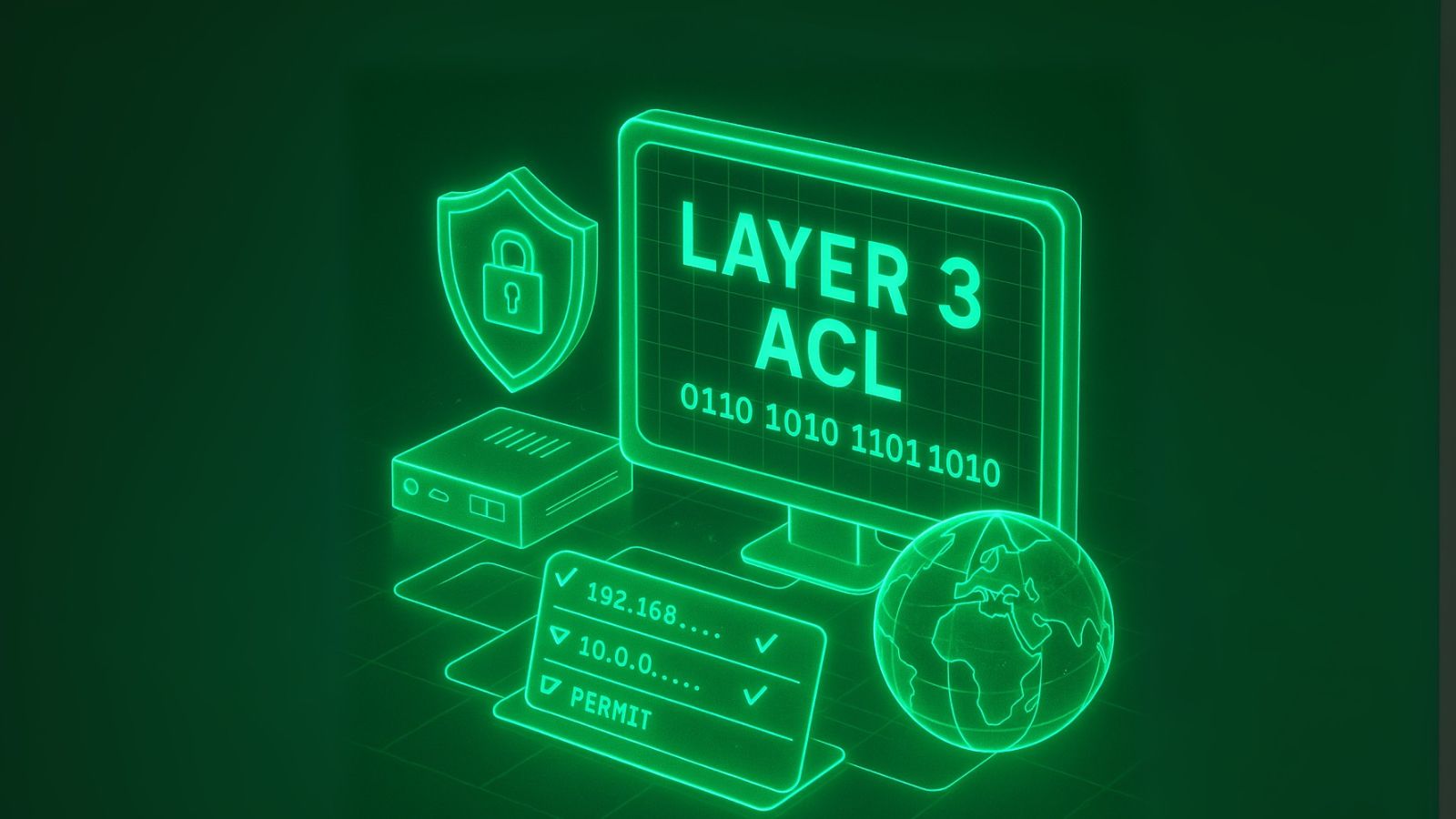How many malicious packets does your firewall block daily? And how many should it be blocking—but isn’t?
In most enterprise networks, Layer 3 Access Control Lists (ACLs) are the first line of defense against unwanted traffic. They’re foundational to IP-based filtering—but their simplicity is both a strength and a fatal weakness. As attackers grow more sophisticated and networks become dynamic, Layer 3 ACLs are being pushed to their limits.
Let’s unravel what they are, how they work, and whether they still have a future in modern security architecture.
How Layer 3 ACLs Relate to NIST SP 800-207
Although Layer 3 ACLs were not designed with Zero Trust in mind, they still have a limited role to play in architectures aligned with NIST SP 800-207. The framework emphasizes dynamic, identity-aware, and context-driven policy enforcement—areas where traditional ACLs fall short. However, when used at the network perimeter or in cloud-native environments (like security groups or NSGs), ACLs can serve as a coarse-grained gate before Zero Trust policies are applied deeper in the stack. Their simplicity makes them fast, but they must be paired with modern controls like identity verification, posture checks, and continuous authentication to align with Zero Trust principles.
Why ACLs Alone Can’t Support the Architecture of Microsegmentation
The architecture of microsegmentation is designed to operate with deep awareness of users, devices, applications, and behavior—not just IP addresses. Layer 3 ACLs, while effective for basic network segmentation, lack the granularity and context needed for true east-west traffic control within modern data centers or hybrid environments. Microsegmentation requires enforcement points that can dynamically adapt to changes in workloads, user identity, and device posture. Static ACLs simply can’t keep up with this level of responsiveness. To support microsegmentation, organizations must integrate identity-based access, automation, and real-time telemetry into their security fabric.
Step-by-Step Flow
What Are Layer 3 ACLs?
Layer 3 ACLs are rule-based filters that control IP-based traffic flow at the network layer (Layer 3 of the OSI model). They’re typically used in routers, firewalls, and switches to permit or deny traffic based on the source and destination IP addresses.
Components Involved:
Component | Role |
Router or Firewall | Hosts the ACL |
Control Plane | Parses and stores ACL rules |
Data Plane | Applies ACL rules in real-time traffic handling |
Inputs to ACL:
- Source IP
- Destination IP
- Protocol (TCP, UDP, ICMP)
Outputs:
- Permit or deny packet decision
- Logging or alert (optional)
Typical ACL Syntax and Structure
An ACL is a list of ordered rules. Each rule is evaluated sequentially until a match is found.
Example Rule (Cisco-style):
bash
CopyEdit
access-list 101 permit ip 192.168.1.0 0.0.0.255 10.0.0.0 0.0.0.255
What it means:
Allow all IP traffic from subnet 192.168.1.0/24 to subnet 10.0.0.0/24.
Rules are order-dependent: the first matching rule determines the fate of the packet. There’s usually an implicit “deny all” at the end of the list.
Where ACLs Are Deployed
Common Use Cases:
Environment | ACL Use |
Data Center | Segment VLANs or zones |
Campus Network | Block guest access to internal servers |
Cloud Network (e.g., AWS Security Groups) | Control traffic between instances |
WAN Routers | Filter outbound or inbound routes |
ACLs are usually deployed at network boundaries, not inside application layers. That’s part of why they’re fast—but limited in scope.
Enforcement Logic and Path
When a packet hits an interface, it is evaluated in real-time by the router or firewall’s data plane. The ACL check must happen at line rate, or the performance of the device drops.
Enforcement Flow:
- Packet received at ingress or egress interface
- Control plane loads ACL rule set into data plane
- Data plane matches packet headers against rules
- Decision: permit/deny/log
Metrics to Track
Metric | Why It Matters |
Rule hit count | Shows rule effectiveness |
Packet drop rate | Indicates potential threats or misconfigurations |
Latency impact | Poorly written ACLs can increase processing time |
Rule overlap/conflict | Can cause unintended access or blockage |
Rule utilization | Helps identify stale or unused entries |
Points of Failure: Where ACLs Fall Short
Scalability
Layer 3 ACLs become unwieldy as environments grow. Managing thousands of IPs and exceptions leads to rule bloat and human error.
Lack of Context
They have no awareness of:
- User identity
- Application type
- Time of day
- Device state
This makes them blind to modern threats that use legitimate IPs with malicious intent.
IP Spoofing
Since ACLs rely solely on IP addresses, they’re vulnerable to spoofing—especially in flat or poorly segmented networks.
Static Nature
ACLs are mostly manually managed. They don’t automatically adapt when apps scale, users move, or cloud workloads change addresses.
Root Cause:
- No rule simulation before deployment
- Lack of “deny by default” at the top
- Human error in sequencing
Do ACLs Still Matter in Zero Trust?
Yes—but only as a component, not a strategy.
Roles in Zero Trust:
ACL Type | Role |
Ingress ACL | First gate before reaching workloads |
Cloud-native ACLs | Used with Security Groups or NSGs |
Microsegmentation ACLs | Enforced at host-level for east-west traffic |
However, in Zero Trust, identity, behavior, and context matter more than IP. So ACLs are being replaced or augmented by identity-based policies.
ACLs vs. Identity-Aware Access Control
Feature | Layer 3 ACL | Identity-Based Access |
Scope | IPs/Subnets | Users, devices, roles |
Context Awareness | ❌ | ✅ |
Dynamic Adaptation | ❌ | ✅ |
Cloud Native Support | Partial | Full |
Lateral Movement Blocking | Basic | Precise |
Recommendations for Modern ACL Usage
- Segment by subnet only where necessary
Avoid sprawling IP ranges that require broad “allow all” rules. - Use ACL simulation tools
Pre-validate the rules for shadowing, overlaps, and policy gaps. - Automate with infrastructure-as-code
Manage ACLs using tools like Terraform, Ansible, or custom APIs. - Combine with identity tools
Use them as the first gate, but pair with ZTNA or EDR to enforce deep security. - Log everything, audit frequently
The silent failure of ACLs is their lack of visibility without aggressive logging.
TL;DR Box – The Gist in 30 Seconds
- Layer 3 ACLs filter traffic based on IP addresses and protocols—they’re fast and simple, but context-blind.
- They struggle with scalability, dynamic environments, and insider threats.
- ACLs are still useful in Zero Trust—but only when paired with identity and behavioral context.
- Misconfigurations are common; automation and rule simulation are critical.





